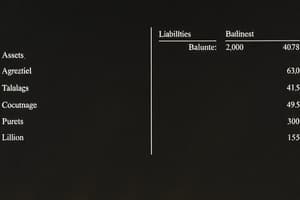Podcast
Questions and Answers
What is a Balance Sheet?
What is a Balance Sheet?
- A summary of the income and expenses over a period of time
- A report of cash flows during a specific period
- A listing of an organization's assets, liabilities, and equity at a point in time (correct)
- A document detailing stockholder's equity changes
What do assets represent?
What do assets represent?
The amount of resources owned by an entity, including probable future economic benefits obtained due to past transactions.
What are liabilities?
What are liabilities?
Amounts owed to other entities, representing probable future sacrifices of economic benefits due to present obligations.
What is Stockholders' Equity?
What is Stockholders' Equity?
How do you calculate Stockholders' Equity?
How do you calculate Stockholders' Equity?
What is the high level calculation for a Balance Sheet?
What is the high level calculation for a Balance Sheet?
What are current assets?
What are current assets?
What are long-term assets?
What are long-term assets?
What are current liabilities?
What are current liabilities?
What are long-term liabilities?
What are long-term liabilities?
What is the purpose of an Income Statement?
What is the purpose of an Income Statement?
How do you calculate the Income Statement?
How do you calculate the Income Statement?
What are 3 other names for the Income Statement?
What are 3 other names for the Income Statement?
Where are income taxes shown on the Income Statement?
Where are income taxes shown on the Income Statement?
Where is Earnings per Share shown on the Income Statement?
Where is Earnings per Share shown on the Income Statement?
What does the Statement of Changes in Stockholders' Equity report?
What does the Statement of Changes in Stockholders' Equity report?
What are retained earnings?
What are retained earnings?
Flashcards are hidden until you start studying
Study Notes
Balance Sheet
- Presents an organization's assets, liabilities, and equity at a specific point in time.
- Follows the equation: Assets = Liabilities + Stockholders' Equity, ensuring balance.
Assets
- Resources owned by an entity with probable future economic benefits from past transactions.
- Divided into current assets, convertible to cash or benefits in one year, and long-term assets held for several years.
Current Assets
- Include cash, accounts receivable, and merchandise inventory.
- Expected to be converted into cash or used within one year.
Long Term Assets
- Comprise property, plant, and equipment (PP&E), intangible assets like goodwill, patents, and research and development costs.
- Not intended for immediate sale and held for long-term use.
Liabilities
- Obligations owed to other entities, indicating future sacrifices of economic benefits.
- Classified into current liabilities due within one year and long-term liabilities not due within one year.
Current Liabilities
- Include short-term debt, accounts payable, and accrued liabilities.
- Obligations that the entity expects to repay within one year.
Long Term Liabilities
- Examples include bonds payable, long-term loans, capital leases, and deferred compensation.
- Not expected to be settled within one year of the balance sheet date.
Stockholders' Equity (SE)
- Represents stockholders' ownership in the company’s assets after deducting liabilities.
- Often referred to as net assets.
Calculating Stockholders' Equity
- Calculated by subtracting total liabilities from total assets.
Income Statement
- Reports net income or net loss over a specific period, providing insights into the company's profitability.
- Shows revenues from operating activities and subtracts related costs and expenses.
Other Names for Income Statement
- Known as statement of earnings, profit and loss statement, or statement of operations.
Income Taxes
- Displayed after other income statement items as a function of income before taxes, impacting net income.
Earnings Per Share (EPS)
- Reported at the bottom of the income statement, reflecting its significance for assessing the market value of common stock.
Statement of Changes in Stockholders' Equity
- Details changes in paid-in capital and retained earnings during the year.
- Explains the balances found in the stockholders' equity section of the balance sheet.
Retained Earnings
- Account for net income or loss reported since the company's inception, showcasing cumulative profitability.
Studying That Suits You
Use AI to generate personalized quizzes and flashcards to suit your learning preferences.




